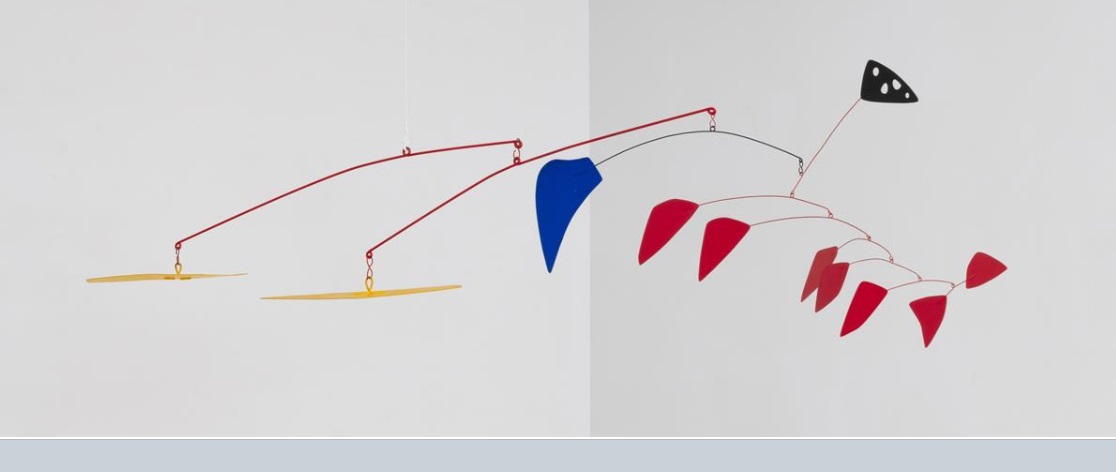For each of them Calder establishes a general fated course of movement, then abandons them to it: time, sun, heat and wind will determine each individual dance… Each of its twists and turns is an inspiration of the moment… It is a little hot-jazz tune, unique and ephemeral, like the sky, like the morning.
-Jean-Paul Sartre, 1947
[NEW YORK -April, 2024] — GRAY is pleased to announce Calder, an exhibition of sculptures by Alexander Calder from the 1950s and 60s. The decades at mid-twentieth century were especially significant for the artist, whose objective to create space and movement at ever more immersive scales is expressed by the range of work in the exhibition. From the intimate interplay of color seen at a small scale in Contrepoids jaune, c. 1953 to the monumental statement in black and white of Clouds over Mountains, 1962, one experiences the breadth of Calder’s invention in color, volume, form, gesture, and motion.
Calder is the twelfth exhibition at GRAY to include works by the artist, whose 1966 solo show at Richard Gray Gallery was installed at the gallery’s very first location in Chicago. The exhibition opens at GRAY New York (1018 Madison Avenue) on April 18 and will be on view through June 21, 2024.


Clouds over Mountains.
At the center of the exhibition is the large-scale sculpture Clouds over Mountains, which combines a series of angular black silhouettes with four curved white forms that hover above. Celebrated in the year it was made by leading critics such as John Canaday and Donald Judd, Clouds over Mountains is a seminal work, representing a milestone in Calder’s development of expansive standing mobiles.
The exhibition also features two important mobiles: Horizontal Red Moon Gong, 1957 and The Two Yellows, 1962. Both hanging mobiles, the works are key examples of Calder’s ability to find harmonic balance in an orchestra of counterweighted elements created in painted sheet metal, and brass in the case of the former work.
The exhibition takes place in GRAY’s New York gallery on the Upper East Side, the entrance of which is framed by a terrazzo sidewalk designed by Calder in 1970. The sidewalk, a cunning pattern of arcs and rectangles, was commissioned by three galleries then located on the block–including Calder’s long-time gallery Perls Galleries–and stretches from 1014-1018 Madison Avenue.
Calder at GRAY reactivates the physical location of the gallery. From the dynamic sculptures installed within the gallery to the geometric forms fixed in terrazzo outside, Calder’s eye for kinetic potential endures.
ABOUT ALEXANDER CALDER
Alexander Calder (b. 1898, Lawnton, Pennsylvania–d. 1976, New York City), whose illustrious career spanned much of the twentieth century, is the most acclaimed and influential sculptor of our time. Born in a family of celebrated, though more classically trained artists, Calder utilized his innovative genius to profoundly change the course of modern art. He began in the 1920s by developing a new method of sculpting: by bending and twisting wire, he essentially “drew” three-dimensional figures in space. He is renowned for the invention of the mobile, whose suspended, abstract elements move and balance in changing harmony. From the 1950s onward, Calder increasingly devoted himself to making outdoor sculpture on a grand scale from bolted steel plate. Today, these stately titans grace public plazas in cities throughout the world.
Calder’s 1966 inaugural solo presentation at GRAY was the first of a number of exhibitions to feature the artist across the decades, including Sculpture Works on Paper, 1974; Contemporary Masters, 1987; Forty Years, 2003; Fun House, 2013; GRAY at 60, 2023; and most recently Calder, 2024.
Featured image: Alexander Calder, The Two Yellows, 1962.
© 2024 Calder Foundation, New York / Artists Rights Society (ARS), New Yor


Leave a Reply
You must be logged in to post a comment.